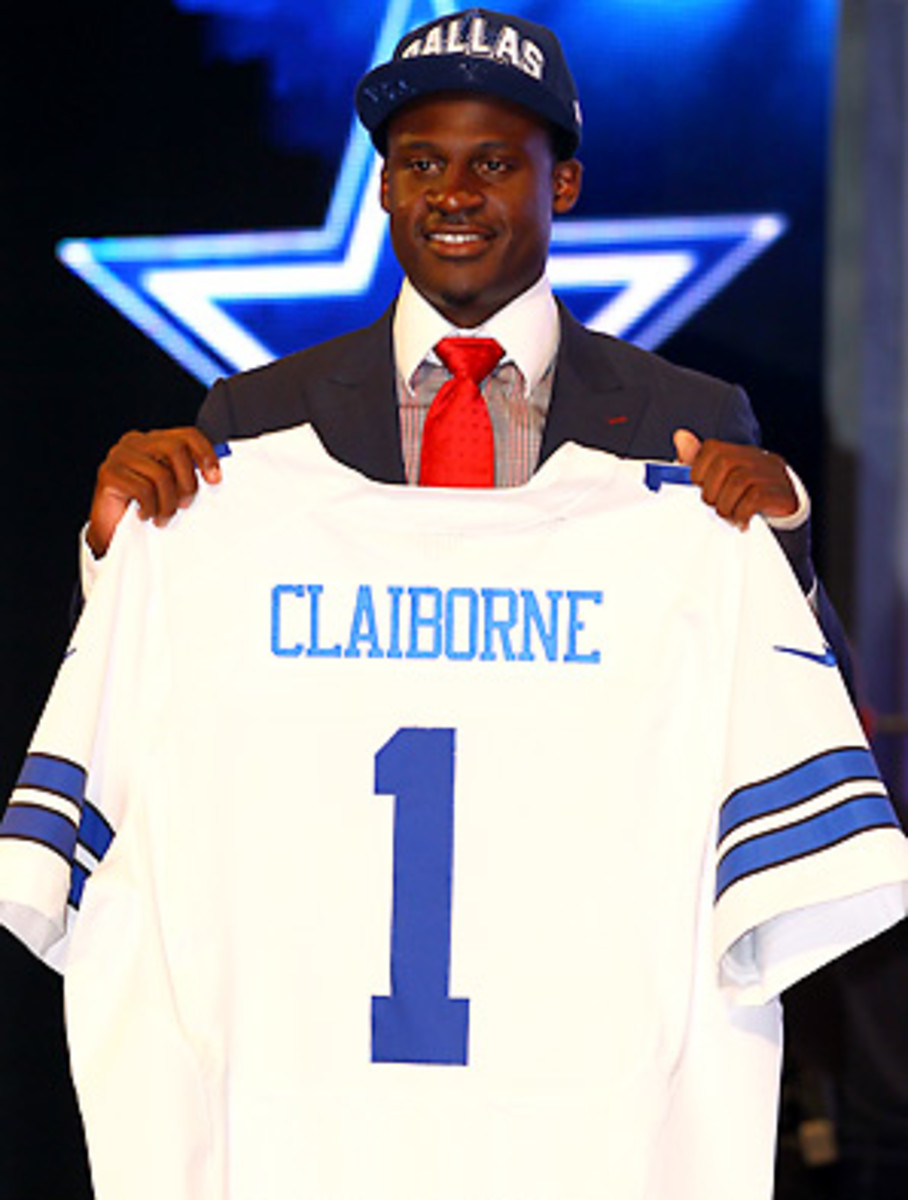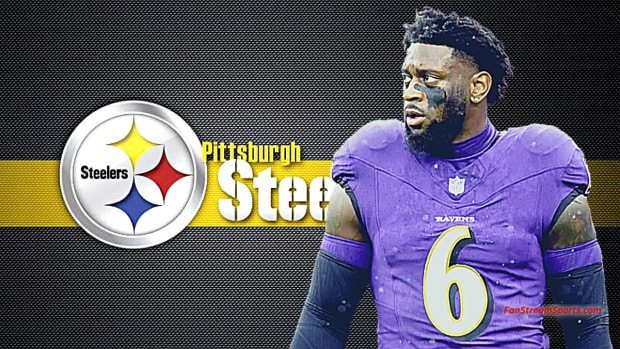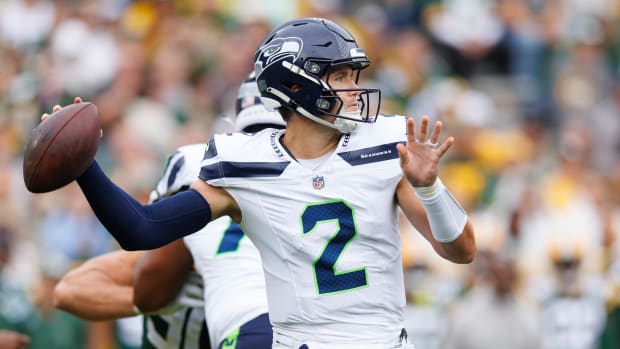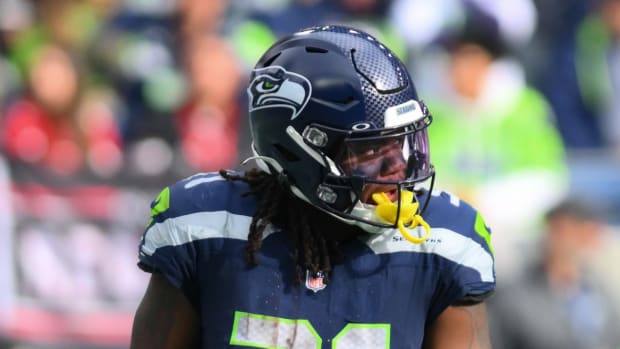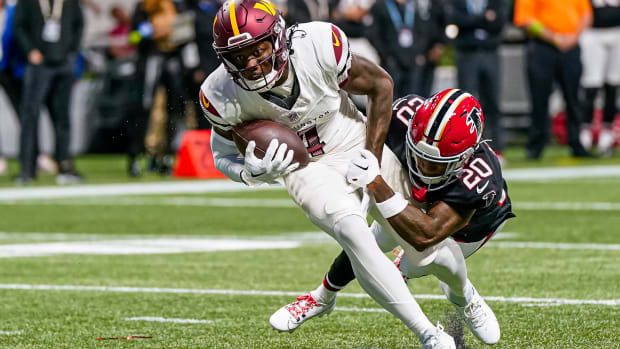First-round trade flurry thanks to rookie wage scale; more Snaps
• The star of the NFL draft's first round was rather predictably a rookie, but not any of those we've spent months focused on. Let's hear it for the first year of the rookie wage scale, which produced for us one of the most entertaining, eventful and trade-filled first rounds in memory.
True, last year at this time the NFL knew it was headed for a rookie salary scale whenever a new collective bargaining agreement came together. But this was the first draft where that wage structure impacted the moves that were made in the first round, and it did so on a scope that was writ large.
All told, teams that held six of the first seven draft slots this year traded out of them, in a flurry of activity that eventually encompassed nine of the first 15 spots in the first round, and 14 of 32 slots overall. In other words, nearly half of the round made a move.
The 19 overall trades executed in the first round (three of which happened last year, involving Atlanta, New Orleans and Oakland) were the most in the NFL since the 1970 merger, and in that season there were only 26 teams in the league.
The simple reason for so many teams doing so much dealing? Because they could, thanks to a rookie wage scale that established cost certainty for teams, allowing them to wheel and deal to their heart's content. No longer is the guaranteed money in the first round draft prohibitive, and trade-discouraging.
Especially for the teams at the top of the draft, the trades were fast and furious, with losing franchises making big moves that hopefully portend a rise to the top of the standings. As it turns out, the blockbuster Robert GriffinRams-Redskins deal in early March was just foreshadowing for the frenzy to come Thursday night.
From the original order of the top seven, the No. 1 Colts were the only team to wind up standing its ground, taking Stanford quarterback Andrew Luck as we all expected since January or so. After the Redskins took Griffin No 2, the No. 3 Vikings and No. 4 Browns swapped places with Cleveland moving up for Alabama running back Trent Richardson, and Minnesota getting USC offensive tackle Matt Kalil, plus three more Browns draft picks for their trouble.
But that was just the warm-up. No. 5 Tampa Bay and No. 7 Jacksonville executed a deal that flopped their selections, with the Jags coming up to get Oklahoma State receiver Justin Blackmon, and the Bucs taking Alabama safety Mark Barron two picks later. In between those two Florida franchises, the Cowboys made a splash, moving up from No. 14 to No. 6 St. Louis (via Washington) to nab the object of their eye, LSU's top-rated cornerback, Morris Claiborne. The Rams slid down to the 14 spot and took Claiborne's Tigers teammate, LSU defensive tackle Michael Brockers.
No. 12 Seattle and No. 15 Philadelphia did the trade tango as well, as did No. 21 Cincinnati and No. 27 New England, and then, No. 25 Denver and No. 31 New England (the Patriots were double-dippers in the first-round trade market, as were the Rams). And we still weren't done. No. 29 Baltimore traded out of the first round altogether, shipping it to Minnesota, which took its second stab in the opening round, and finally, No. 31 Denver dealt downward for a second time, sending its pick to Tampa Bay, which also positioned itself for a two-pick first round. Like the Ravens, the Broncos didn't make a pick in the first round.
Any way you dissect it, the rookie wage scale added a major shot of juice to this year's first round, and in drastically limiting a team's exposure to financial risk, made it cool to trade in the NFL's biggest poker game of the year. After having just four trades involving top-five picks since 2000, we had four of this year's top five teams making deals in the NFL's new world order.
The swap meet was breathtaking to watch unfold, and a lot of fun. And I think the trend is here to stay, at least through the end of the current 10-year CBA. In the NFL this season, my rookie of the year is the rookie wage scale.
• Not that it has become a passing league or anything, but the first round's top 10 included three quarterbacks for the second time in two years, and three defensive backs for the first time since 2005 (when Pacman Jones, Antrel Rolle and Carlos Rogers went in the high-rent district).
That's 60 percent of the top 10 devoted to either passing the ball, or stopping the passing game, and that doesn't even include Oklahoma State receiver Justin Blackmon's passing game impact, in the No. 5 slot to Jacksonville. Those who throw the ball, and those who can frustrate the passers, have never been more valuable or sought after.
• All the trades almost served to overshadow the quarterback stories in the first round beyond Andrew Luck and Robert Griffin, but Ryan Tannehill to Miami at No. 8 and Brandon Weeden to Cleveland at No. 22 means the next two passers at least went to the most obvious, quarterback-needy teams in the league.
Tannehill clearly falls into the best possible spot for him. His old collegiate coach at Texas A&M, Mike Sherman, is his new offensive coordinator, and he'll be familiar with the system from day one. In addition, he'll likely get most of the year to watch and learn as a combination of Matt Moore and David Garrard get the playing time in Miami.
But with Weeden, the story is different. I like that Cleveland aggressively went after the former Oklahoma State quarterback, but his time is now. He'll be 29 by the time football season arrives, and you have to think the Browns didn't spend a first-round pick on someone to back up a third-round pick (in 2010) for long. Look for Weeden to push McCoy from the first day of training camp on.
If you're keeping score, it's the second straight year there have been four quarterbacks taken in the first round, although it fell between picks 1-22 this year. In 2011, Cam Newton (No. 1) Jake Locker (No. 8), Blaine Gabbert (No. 11) and Christian Ponder (No. 12) all went in the top dozen selections.
• I heard no one send anything but bouquets Luke Kuechly's way in the pre-draft scouting season, but him going No. 9 to Carolina at least should give the Panthers' pause (or paws?) based on the recent track record of top 10 linebackers.
Do the names Ernie Sims, Aaron Curry, A.J. Hawk, Keith Rivers and Rolando McClain still ring a bell? It hasn't been pretty of late, but Kuechly doesn't seem to scare people. Maybe it's because he's such a rarity as a three-down player who is better in pass coverage even than he is against the run.
• I love that defense the Bills are building for themselves. Between last year's first-round pick, defensive tackle Marcell Dareus, this year's free-agent additions, defensive ends Mario Williams and Mark Anderson, and this year's No. 10 pick, South Carolina cornerback Stephon Gilmore, Buffalo has the guts of a good, young D in place.
The Bills still need more offense to fully compete in the AFC East, but it's easy to see the wisdom of their blueprint on defense. Get pass rushers and cover men, and try like heck to stop that vaunted Tom Brady-led Patriots passing game.
• There was no bigger surprise Thursday night than Seattle taking West Virginia defensive end Bruce Irvin, a former high school drop-out who has more than his share of character red flags. Irvin has undeniable pass rush skills, but Seattle passed up the likes of Quinton Coples, Chandler Jones and Melvin Ingram to take him.
My question? Even if Seattle had a strong conviction about him, did they not stand a pretty good chance of moving back again from No. 15 in order to take him lower in the round and still garner more draft picks? Irvin is said to have a tremendous burst around the edge, and at 6-foot-3, 248 pounds with 4.48 speed, he sounds like a pure pass-rusher who Pete Carroll is hoping to turn loose on opposing offenses.
Seattle plans on using him as a situational pass rusher this season, and then is counting on him growing into full-blown beast mode coming off the edge. At No. 15 in the draft, he has to be more than a part-time player, and soon. The Seahawks are taking a gamble on a player they think they know well enough to bet on. But Irvin begins his NFL career with perhaps more doubters than any other of Thursday's first-round picks.
• Kansas City's general manager Scott Pioli is thought to be risk-averse, but he made one of the bigger rolls of the dice Thursday night when his Chiefs made Memphis defensive tackle Dontari Poe their first-round pick at No. 11. Poe is massively gifted from an athletic standpoint, but his game film was less than inspiring in 2011.
That's the thing about those boom-bust types. You ever notice the boom part gets mentioned first, sometimes distracting us from the bust possibility?
• Larry Fitzgerald got his wish and the Cardinals drafted Michael Floyd, selecting the talented Notre Dame receiver even though Arizona's offensive line probably could have used help in the form of either Stanford guard David DeCastro or Iowa tackle Reilly Reiff a little more so.
So now the pressure's really on Kevin Kolb in the desert. With Fitzgerald and Floyd to throw to, what's Kolb's excuse now if he doesn't get it done?
• North Carolina defensive end Quinton Coples was one of the most gifted pass rushers in this draft, and the Jets definitely need help getting to the opposing quarterback. But when you have a locker room that was a cesspool on the chemistry front last season, is it wise to make your first-round pick a player whose largest knock was that he didn't play consistently hard enough?
I guess it's still a case of in Rex they trust in New York. Still.
• A trade in front of them conspired to keep the Rams from getting the player they really wanted in Blackmon, who went fifth overall, one spot ahead to the Jaguars. So St. Louis just regrouped and dealt down a second time in the round, dropping from sixth to 14th, with Dallas coming up for Claiborne. The Rams took LSU's Brockers, who fills a major need on the defensive line.
And boy do the Rams now occupy the catbird seat going into Friday night's second round. St. Louis owns the No. 33 selection, the first pick of the round, which is always coveted by teams that didn't get the player it wanted in the first round and are entertaining a trade back up to land that spot. In addition, St. Louis has the No. 39, a pick acquired in the Redskins trade, and No. 45, which the Cowboys sent them for the right to move up eight spots to sixth.
So far, this rebuilding program in St. Louis is unfolding at warp speed in the Jeff Fisher coaching era. The second round could be a bonanza for the Rams, perhaps setting them up with at least three new starters.
• More than ever, the draft has really become a big, eye-catching show more than an event. It's an orchestrated extravaganza with more show business than football at its core. That's how you get ridiculous TV ratings in the middle of spring, almost three months after the last meaningful game of the season has been played, despite doing nothing more than reading names off a list and running some interviews and B-roll.
It's a marvel, really. In some ways, the draft has become bigger than any game on the NFL schedule, even the monstrosity that is the Super Bowl, in that it inspires more than three months of steady coverage and buildup. And gets exponentially bigger each and every year.
































